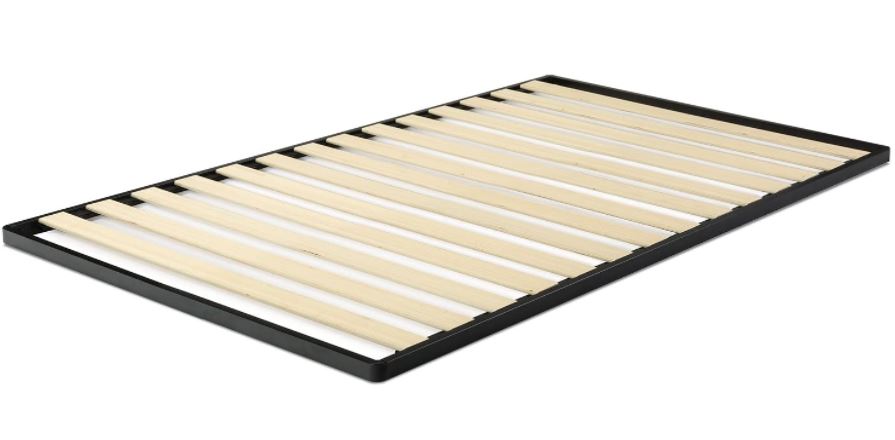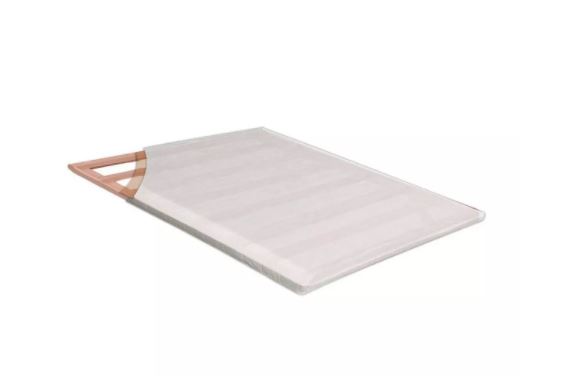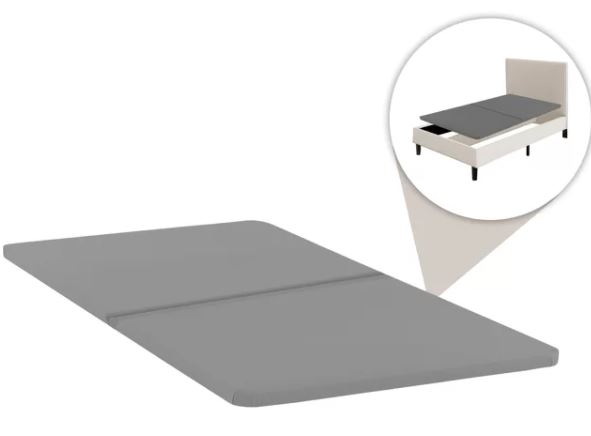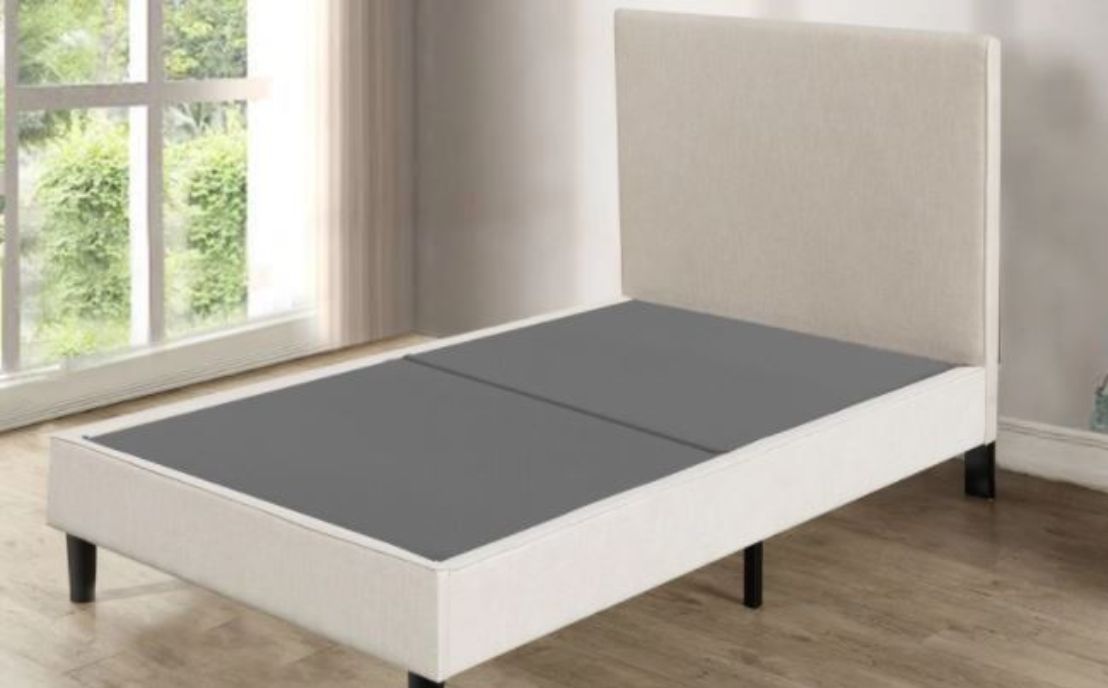If you’ve ever looked for a good mattress or bed frame, you’ve probably come across the word “bunkie board” (also spelled “bunky board”). You’ve always heard about box springs…
So, what is a bunkie board? If you’ve ever looked for a good mattress or bed frame, you’ve probably used the word “bunkie board” (also spelled “bunky boards”). Box springs and other types of bed frames, such as slatted frames, are probably common to you. But what exactly is a bunkie board and why would you need one? We’re here to answer these and other questions.
I will also mention five of my favorite bunkie boards of different sizes within this post.
What is a Bunkie Board?
A bunkie board is a 1 to 3-inch flat barrier made of wood, plywood, or particleboard that fits between your mattress and the surface on which it lies. It can be used with any kind of bed frame or foundation, including metal frames, solid platforms, box springs, and slatted foundations. Let’s take a look at how bunkie boards came to be before we get into why you would need one.

The bunkie board above is available in Twin size and comes with a 5-year warranty.
How do bunkie boards function?
Instead of a box spring, bunkie boards are mounted on top of a regular bed frame. Following that, the mattress is mounted directly on top of the floor.
The aim of your bunkie system is to keep the mattress in place. NOTE: If you bought a “platform bed,” you won’t need a bunkie board because platform beds already have slats.
Is there a Queen size bunkie board
The metallic bunkie board below comes in queen size. It is suitable for providing additional support for spring, hybrid, and memory foam mattresses. Check it on Amazon.

A solid bunkie board can help spread the weight of the sleeper evenly over the mattress, resulting in a more stable base and consistent weight distribution, reducing sagging and “soft spots.” Bunkies have a lower profile than box springs (2′′ vs. 9′′), meaning the mattress would be closer to the edge.
When to use a bunkie board
When customers want their mattress to be lower to the ground, they should choose a bunkie board rather than a box spring. A bunkie board is just 2 inches thick and provides stability without the added height of a conventional box spring.
Is a box spring needed when using a bunkie board?
Instead of a box spring, a bunkie board is used. Just make sure it’s well-made, as a cheap one might not provide the necessary help.
What is the history of bunkie boards?
Bunkie boards, as the name implies, were originally used as a foundation for a bunk bed mattress. Traditional innerspring mattresses (which were the norm for many years) required a box spring for support, and bunk bed sleepers needed a solution.
Box springs that are too thick will not work on either the top or bottom bunk. When bunk bed sleepers stood up with a mattress and box spring, they would reach the ceiling or the bed above them.
As a result, the bunkie board was developed. The box spring was replaced by these sheets, allowing bunk bed mattresses to sit low.
Bunkie boards weren’t always called that or designed the way they are now. These foundations originally consisted of a single solid piece of wood or plywood that supported the entire mattress. Bunkie boards now come in a variety of lengths, widths, and thicknesses, and are made of wood stripes. Any mattress size is compatible, including twin, twin XL, double, queen, king, and California king. Decorative bunkie boards can be purchased to fit the look and style of your bed frame.
California King bunkie board
This 2-inch bunkie board comes in California king size and is uniquely designed to be thin offering a smooth touch finish. It is available on Target.

What Is the Purpose of a Bunkie Board?
Box springs fit well with traditional spring mattresses. They assist in the absorption of some of the burden as well as providing additional assistance. Modern mattresses, such as memory foam and hybrid mattresses, do not require a box spring; in reality, most manufacturers advise against using one. Since foam (including poly-foam, memory foam, and latex foam) and hybrid mattresses can sag if they aren’t resting on a firm, flat surface, they can sag.
To secure a foam or hybrid mattress, it must be put on a firm foundation. You can use a buffer between the mattress and the frame if you don’t have a bed frame with a solid foundation. Bunkie boards come in handy in this situation. To build a solid, durable surface for your new mattress, place these wood barriers on top of any bed frame or base (including slatted frames).

Foundation provides adequate support for your mattress, allowing you to fully appreciate the comfort and support that a bed provides.
The mattress can develop soft spots or sag if it lacks adequate support. If your body isn’t getting enough help, you can feel back pain.
This superb-looking full size bunkie board is available on Walmart.
What Are the Signs That I Need a Bunkie Board?
If you’ve recently purchased or are considering purchasing a new foam or hybrid mattress, our recommendations below will help you decide if a bunkie board is right for you.
Bunkie boards are not needed if you intend to position your mattress on a bed frame that already has a solid foundation (no slats). If you want a higher bed, a bunkie board is a perfect way to add height to your mattress without jeopardizing its structural integrity.
Slatted Foundations: If your bed frame has slatted foundations, you can put a bunkie board on top of the slats and rest your mattress on it. You can choose between a 1-inch, 2-inch, or 3-inch bunkie frame, depending on how high you want your bed to sit.
Bunkie Board Isn’t Necessary If You Have An Adjustable Foundation: If you have an adjustable bed, you won’t need a bunkie board. Anything between the mattress and the frame will prevent the frame from properly bending.
Best bunkie board so far
The 1.5-inch Bunkie Board available on Wayfair is so far our best in the list. It comes split in two, making it easy and convenient to carry, travel and store.

The only limitation is that it comes in Twin Size. We couldn’t locate bigger versions for queen and king beds.
The distinctions between bunkie boards and other bed bases are outlined below.
If I have bed slats, do I need to install a bunkie board?
A bunkie board does not have the same level of protection as bed slats. If your bed already has slats, a bunkie board isn’t necessary unless your bed needs more support.
Box Spring vs. Bunkie Board
Originally, conventional box springs were used to complement the innerspring mattress. Spring coils were found in both layers, which operated together to control weight distribution and strain. Many modern box springs, on the other hand, are made up of a wood or metal box with a fabric cover. They don’t add anything to the mattress above in terms of stability or support.
Since not all box springs have a sturdy surface, most foam and hybrid mattresses can’t rely on them as a foundation. It’s best to get rid of your old box spring and put your new foam bed on a strong base or a bunkie board if you have a more modern bed.
If you want to keep your box spring, you can put a bunkie board on top of it to give the mattress a strong foundation. However, before you do so, double-check the warranty on your mattress. Some warranties can expressly forbid the use of a box spring. You can also make sure that your box spring can support the weight of a bunk bed and a foam mattress.
Plywood vs. Bunkie Board
Instead of using a bunkie board, a sturdy piece of moisture-resistant plywood can be placed under your mattress. The plywood should be at least 34 inches thick and suit your bed perfectly. This choice is less expensive, but make sure your mattress and frame measurements are accurate. It won’t fit snugly otherwise. If you plan to hold your box spring, you can use this sheet of plywood to cover your foam mattress by placing it on top of it.
A bunkie board, on the other hand, can last longer, look cleaner, and protect against damage better than a sheet of plywood. Plywood is prone to chipping and can snag your bedding or mattress. Bunkie boards are designed to carry the mattress and are thus simpler and better to use in the long run.
Slats vs. Bunkie Board
If the slats are more than 2 inches apart, most latex mattresses cannot be mounted on a slatted base. Bed slats for memory foam mattresses should be no more than 3 inches apart. If these foam beds are placed on the wrong surface, they will not provide enough support and will easily deteriorate.
A slatted base is used on the majority of modern bed frames, whether they are made of wood or upholstery. As a result, it’s a good idea to check the mattress warranty to make sure you’re putting your new bed on the right foundation. You can buy a bunkie board if you don’t want to measure the gap between the slats. These bases will safeguard your mattress and keep your warranty valid.
Where Can I Purchase a Bunkie Board?
Bunkie boards can be found in abundance while shopping online. Bunkie boards are also available from mattress and bedroom furniture stores. The majority of furniture stores will assist you in finding the right bunkie board for your bed frame. It’s simple to find the right size bunkie board when using regular US bed sizes, whether you’re shopping online or in a mattress store.
What Does a Bunkie Board Cost?
Bunkie boards range in price from $50 to $150. The price of the bed will rise as the size of the bed increases. A king bunkie board would almost certainly be more expensive than a twin bunkie board. The price may also be influenced by decorative features such as stains and finishes. You could come across some bed frames that come with a bunkie board as you shop.
Bunkie boards give a sleeker, lower-profile look than box springs, which have been the norm for many years. Additionally, they aid in the stabilization of the mattress, allowing it to hold you as intended. When shopping for a new mattress, consider the sort of frame you want to use with it. Regardless of the type of frame you have at home, a bunkie board is usually a comfortable and inexpensive base choice.

